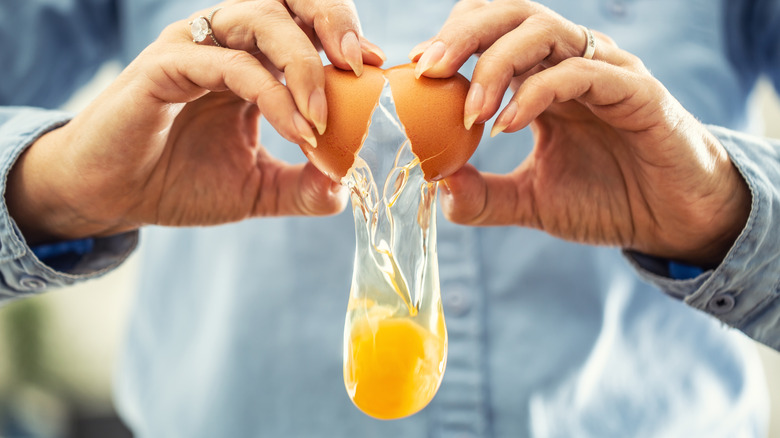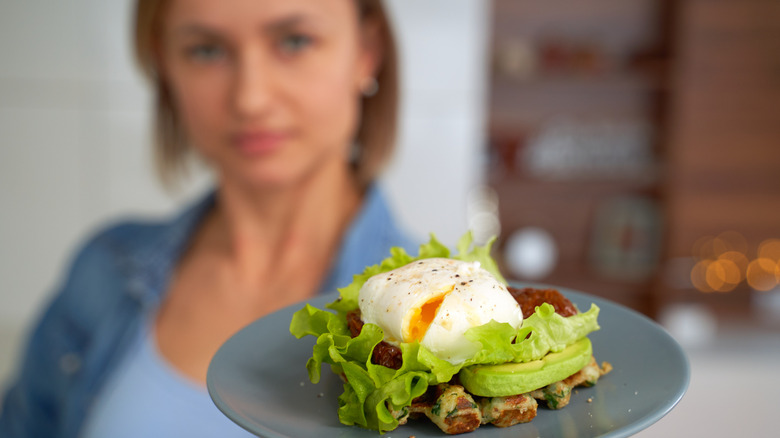
Simpleimages/Getty Images
Eggs are a breakfast staple, a protein powerhouse, and one of the most versatile foods you can crack into a pan. Scrambled, boiled, poached, or fried, eggs show up in everything from Sunday brunch to weeknight dinners. While eggs are loaded with nutrients like protein, B vitamins, and healthy fats, how you cook them can make a big difference in how much of that goodness your body actually gets. (Read what happens to your body if you eat eggs every day.)
One method in particular does a better job at locking in those nutrients than the rest, says Andrea Soares, Registered Dietitian at Top Nutrition Coaching, in a Health Digest interview. “Coddling is basically gently cooking an egg in hot (but not boiling) water–kind of like a warm bath for your egg,” she said. “Because the heat stays lower than in other cooking methods (like frying or hard boiling), it helps preserve delicate nutrients like certain B vitamins and antioxidants.” Moreover, since this cooking method requires no oil or butter, coddling cuts back on unhealthy fats.
Why coddling is a healthier way to cook eggs

Alexander Spatari/Getty Images
Soares says coddling results in a lighter, tender egg because it sets the egg white while keeping the yolk runny. “Plus, a runny yolk may even help with better absorption of fat-soluble vitamins (A, D, E, and K), especially when paired with other healthy fats in your meal,” she said. (Read about other healthy ways to eat eggs, and some you should avoid.)
You’re not alone if you fear eating slightly undercooked eggs. According to FoodSafety.gov, egg dishes should be cooked to 160 degrees to avoid possible salmonella contamination. “Anytime we’re dealing with eggs that have a soft or runny yolk–like in coddling–there’s a small chance of salmonella if the egg isn’t fully cooked,” she said.
To reduce your risk of salmonella contamination, Soares suggests using pasteurized eggs, which use just enough heat to kill any bacteria. “If you’re cooking for someone who’s pregnant, elderly, very young, or has a weakened immune system, pasteurized is the way to go,” she said. You should also buy your eggs fresh from a reputable source and keep them in a refrigerator. When you’re using the coddling method to cook your eggs, the egg whites shouldn’t be jiggling or transparent.
How to enjoy coddled eggs

Petrovich Nataliya/Shutterstock
Soares loves coddled eggs for their versatility. A coddled egg provides a creamy finish on top of avocado toast or a fresh salad. “The yolk doubles as a built-in dressing,” she said. “Try arugula, cherry tomatoes, and a squeeze of lemon.” She’ll also enjoy coddled eggs with sautéed greens and garlic. Fans of brunch may pair a coddled egg with smoked salmon for more protein and some omega-3s. Another healthy option is to make a quinoa or farro grain bowl topped with roasted vegetables, a coddled egg, and some feta.
The classic method for coddling eggs calls for small ramekins to hold the eggs. Set the ramekins in a pot with enough hot water to reach about halfway up the sides, then cover the pot and let the steam gently cook the eggs until the whites are set. If you don’t have ramekins on hand, 4-ounce Mason jars work just as well. Just be careful when removing them from the pot — they’ll be hot.
Credit: healthdigest.com









